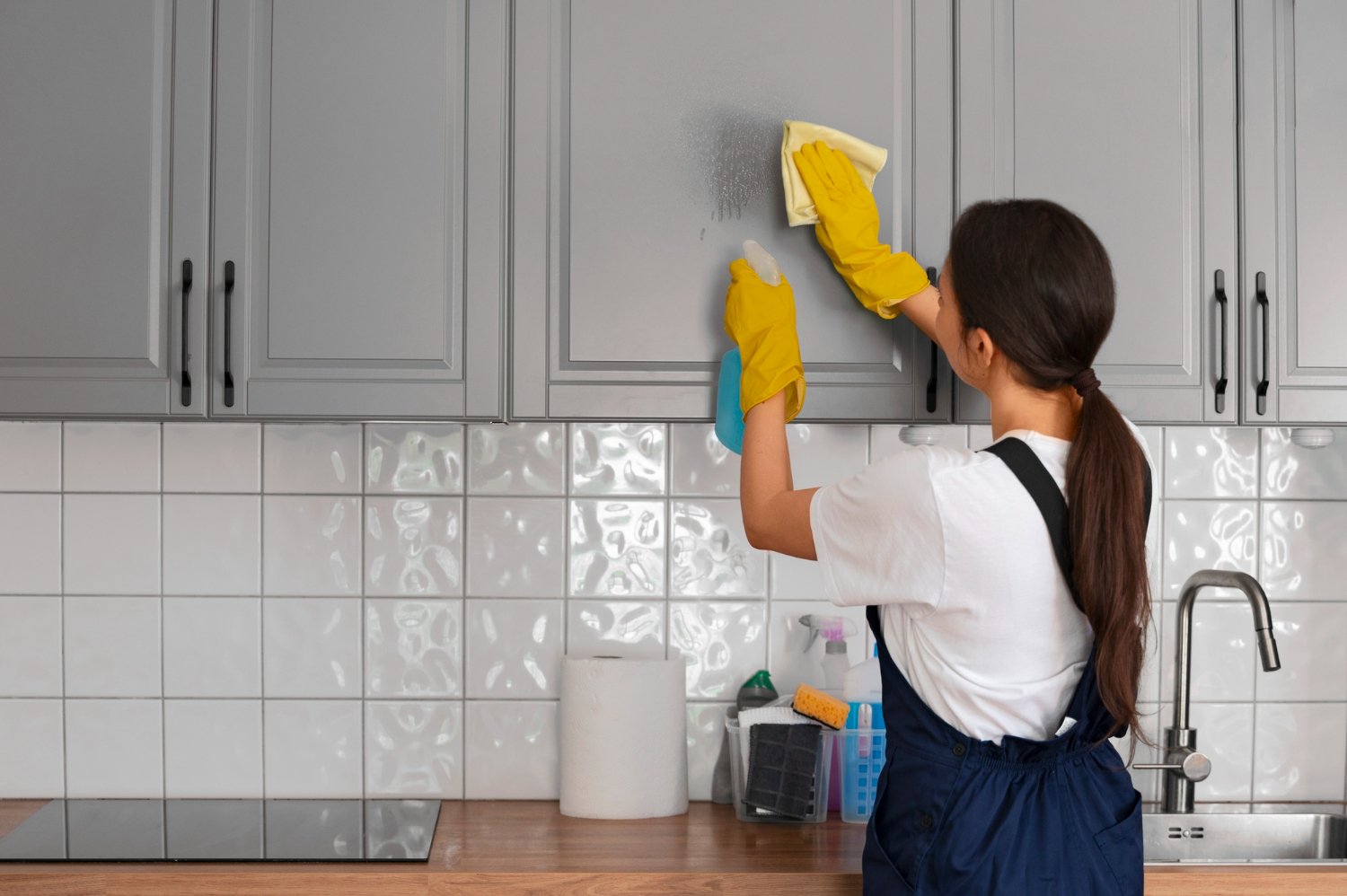
Kitchen cabinets are the unsung heroes of our homes. They hold our dishes, store our food, and frame the heart of the house the kitchen. But over time, they collect a sticky, grimy layer of grease.
As a home improvement expert, I’ve seen it all, and I can tell you that this buildup is completely normal. It’s a natural byproduct of cooking, especially when you love frying, sautéing, or roasting.
That greasy film doesn’t just look and feel unpleasant; it can also damage your cabinet finish and attract more dust and grime. Keeping them clean not only makes your kitchen look better but also helps preserve your cabinetry for years to come.
The good news is you don’t need expensive, harsh chemicals to get the job done. With a few simple ingredients you probably already have, you can make your cabinets look brand new again. In this guide, I’ll walk you through my tried-and-true methods for getting rid of that stubborn grease.
Gather Your Tools and Materials

Before you roll up your sleeves, it’s a good idea to gather everything you need. Having your supplies ready makes the process smoother and faster. Trust me, you don’t want to be running around with a greasy hand looking for a clean cloth.
Here’s what I recommend you have on hand:
- Microfiber cloths: You’ll need at least three—one for scrubbing, one for rinsing, and one for drying. Microfiber is great because it grabs onto grime without being too abrasive.
- A soft sponge: For tougher spots, a non-abrasive sponge can provide a little extra scrubbing power.
- Baking soda: A gentle abrasive that helps break down grease.
- White vinegar: The acid in vinegar is fantastic for cutting through grease.
- Dish soap: A quality dish soap (especially one known for cutting grease) is a must-have.
- Warm water: This will be the base for most of your cleaning solutions.
- A spray bottle: This makes applying your cleaning solution much easier and more even.
- An old toothbrush: Perfect for getting into tight corners, grooves, and around cabinet hardware.
- Optional: A small bowl for mixing pastes.
A Step-by-Step Guide to Sparkling Cabinets

Ready to tackle that grease? Let’s break down the cleaning process into simple, manageable steps. Following this order will ensure you get a thorough, streak-free clean without damaging your cabinets.
Step 1: Prepare the Area
First things first, clear the way. Remove any items from your countertops directly below the cabinets you’re cleaning. This protects them from drips and gives you more room to work. If you’re concerned about your floors or counters, lay down an old towel or some newspaper. I also recommend removing any decorative hardware, like knobs and pulls, if they come off easily. This allows you to clean the surface underneath and clean the hardware separately.
Step 2: Choose and Mix Your Cleaning Solution
You have a few options here, depending on how heavy the grease buildup is. I’ll cover the three most effective methods in the next section. For now, pick one and prepare your solution. For example, if you’re using vinegar, mix equal parts white vinegar and warm water in your spray bottle. If you’re trying a baking soda paste, mix it in a small bowl.
Step 3: Apply and Scrub
Now for the satisfying part. Apply your chosen cleaner to a small, inconspicuous area first (like the inside of a cabinet door) to make sure it doesn’t harm the finish. Once you confirm it’s safe, you can proceed.
Spray the solution directly onto the cabinet surface or apply your paste with a cloth. Let it sit for a minute or two to start breaking down the grease. Then, using a microfiber cloth or soft sponge, gently scrub the surface in a circular motion. For detailed areas or around hardware, use the old toothbrush. Remember to work in small sections so the cleaning solution doesn’t dry before you get to it.
Step 4: Rinse and Dry Thoroughly
This step is crucial for a streak-free finish. After scrubbing a section, dampen a clean microfiber cloth with plain water and wipe away the cleaning solution and grease residue. Be sure to wring out the cloth well; you don’t want to saturate the wood.
Finally, use a third, completely dry microfiber cloth to buff the cabinet surface. Drying thoroughly prevents water spots and protects the wood from moisture damage, leaving a beautiful shine. Once done, reattach your hardware, and you’re all set!
My Top 3 Grease Removal Methods

Not all greasy cabinets are created equal. Some require a light touch, while others need a bit more power. Here are my three favorite DIY cleaning methods, from gentlest to strongest.
Method 1: The Dish Soap Solution
For light, fresh grease, a simple solution of dish soap and water is often all you need.
- How to: Add a few drops of grease-cutting dish soap to a spray bottle filled with warm water. Shake well.
- Best for: Daily or weekly wipe-downs and tackling minor grease spots before they build up. This is my go-to for general maintenance.
Method 2: The Vinegar and Water Spray
For more moderate grease, white vinegar is your best friend. Its acidity is excellent for cutting through grime without being overly harsh.
- How to: Mix a 50/50 solution of white vinegar and warm water in a spray bottle. If the vinegar smell is too strong for you, add a few drops of lemon essential oil.
- Best for: Cabinets with a noticeable but not yet caked-on layer of grease. It’s effective for that sticky feeling that soap and water can’t quite handle.
Method 3: The Baking Soda Paste
For the toughest, most stubborn grease buildup, it’s time to bring out the baking soda. This creates a gentle but effective abrasive paste.
- How to: In a small bowl, mix baking soda with just enough water to form a thick paste. Apply this directly to the greasy spots with a cloth or your fingers. Let it sit for a few minutes before scrubbing gently.
- Best for: Thick, old grease, especially around the stove or on cabinet handles where it tends to accumulate.
Keep the Grease Away
Once your cabinets are sparkling clean, you’ll want to keep them that way. A little prevention goes a long way.
- Wipe Down Regularly: After cooking, give the cabinets near your stove a quick wipe with a damp cloth. This stops grease from building up in the first place.
- Use Your Exhaust Fan: Always turn on your range hood or exhaust fan when cooking. It pulls greasy air and moisture out of the kitchen before it has a chance to settle on your cabinets.
- Clean Spills Immediately: Splatters happen. Wiping them away as soon as you see them is much easier than scrubbing them off later.
A Fresh Start for Your Kitchen
Cleaning greasy cabinets might seem like a daunting task, but it’s one of the most rewarding kitchen cleaning jobs. With a little bit of time and the right natural cleaners, you can completely transform the look and feel of your space. Regular maintenance is the key to preventing heavy buildup, so try to make cabinet wipe-downs a part of your routine.
Your kitchen is the heart of your home, and keeping it clean makes it a more joyful place to be. Now that you have the knowledge, you’re ready to tackle that grease and enjoy your beautiful, sparkling cabinets.
